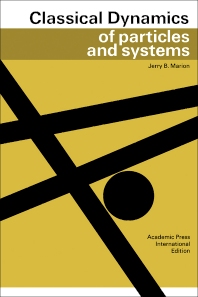

Thornton Charlottesville, VirginiaĪxes x′1 and x′3 lie in the x1 x3 plane. Comments can be sent by email to, the more detailed the better. The author would appreciate receiving reports of suggested improvements and suspected errors.
CLASSICAL DYNAMICS OF PARTICLES AND SYSTEMS PDF MANUAL
Without their help, this manual would not be possible. The author would like to acknowledge the assistance of Tran ngoc Khanh (5th edition), Warren Griffith (4th edition), and Brian Giambattista (3rd edition), who checked the solutions of previous versions, went over user comments, and worked out solutions for new problems. Posting these solutions on the Internet will result in widespread distribution of the solutions and will ultimately result in the decrease of the usefulness of the text. Please do not give students solutions from this manual. It is absolutely forbidden for the students to have access to this manual. And since students may occasionally need hints to work some problems, this manual will allow the instructor to take a quick peek to see how the students can be helped. The instructor will also be able to pick and choose different levels of difficulty when assigning homework problems. Please inform me when either the problem statement or solutions can be improved. Having this solutions manual should provide a greater appreciation of what the authors intended to accomplish by the statement of the problem in those cases where the problem statement is not completely clear. A few of the problems are quite challenging. qualifying examinations in classical mechanics. The instructor will find a large array of problems ranging in difficulty from the simple “plug and chug” to the type worthy of the Ph.D. There are now 509 problems, a significant number over the 4th edition. As a result of surveys received from users, I continue to add more worked out examples in the text and add additional problems. The problem numbers of those solutions in the Student Solutions Manual are listed on the next page. A Student Solutions Manual containing solutions to about 25% of the end-of-chapter problems is available for sale to students. It is intended for use only by instructors using Classical Dynamics as a textbook, and it is not available to students in any form. This Instructor’s Manual contains the solutions to all the end-of-chapter problems (but not the appendices) from Classical Dynamics of Particles and Systems, Fifth Edition, by Stephen T.

Hamilton’s Principle-Lagrangian and Hamiltonian Dynamics

Some Methods in The Calculus of Variations Click on the links to get more information.įind all prizes in | physics | chemistry | physiology or medicine | literature | peace | economic sciences | all categoriesĪlain Aspect, John F.Problems Solved in Student Solutions Manual This means that a total of 221 individuals have received the Nobel Prize in Physics. John Bardeen is the only laureate who has been awarded the Nobel Prize in Physics twice, in 19. The Nobel Prize in Physics has been awarded 116 times to 222 Nobel Prize laureates between 19.


 0 kommentar(er)
0 kommentar(er)
